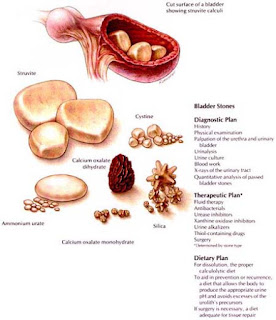Most urinary tract disorders cause some disturbance in the normal pattern of voiding. There are a number of signs to look for.
Dysuria (Painful Urination)
Signs of dysuria are obvious distress during urination with straining, dribbling, licking at the penis or vulva, crying out in pain, voiding frequently in small amounts, squatting but not passing urine after many tries, and/or passing mucus, blood clots, or bloody urine. These signs indicate a disorder of the bladder, urethra, or prostate.
Pain and swelling in the lower abdomen suggest an overdistended bladder. A dog who does not pass urine after prolonged squatting or lifting of the leg is obstructed. This is usually caused by a stone, but could also be due to a tumor obstructing the urine flow.
Hematuria (Blood in the Urine)
Blood in the first portion of urine that clears with voiding indicates a problem in the urethra, penis, prostate, uterus, or vagina. Blood that appears at the end of voiding suggests a disease of the bladder or prostate. A uniformly bloody urine is seen with diseases of the kidneys, ureters, and bladder.
Bleeding without pain suggests kidney disease. Vaginal bleeding may give a false impression of hematuria. Microscopic hematuria means finding red blood cells on microscopic examination of urine that appears normal to the naked eye.
Polyuria (Excessive Urination)
Frequently passing large volumes of urine suggests kidney disease. The dog compensates by drinking large amounts of water. You may notice the increased thirst (polydipsia) first.
Other common causes of polyuria include diabetes mellitus, Cushing’s syndrome, a pituitary tumor, hyperparathyroidism, and some types of poisoning. Polyuria should be distinguished from dysuria and urinary incontinence. more on...
Saturday, August 7, 2010
Subscribe to:
Post Comments (Atom)





0 comments:
Post a Comment